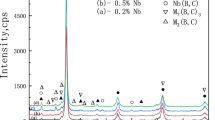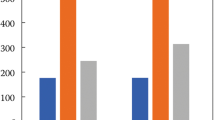Conclusions
As a result of alloying with niobium, the thermal stability of the ribbons investigated increased by 100–150°C over the value for the standard R6M5-type steel containing the same amount of boron. At the same time, the transition temperature of the ribbons to the plastic state almost did not change upon alloying with niobium.
Based on an analysis of the thermal stability of the alloys investigated, we may assume that simultaneous introduction of niobium and boron into them increases the stability of the structure which, in turn, leads to an increase in the thermal stability. This is, apparently, caused by the homogeneous and uniform distribution of the carbides and carboborides of niobium. For an explanation of the mechanism of the thermal stability of the alloys investigated, we need further detailed investigations. However, the generation of a combination of properties of these alloys attained by combined alloying makes them promising for practical applications.
Similar content being viewed by others
References
O. V. Abramov, R. A. Oganyan, Ya. N. Oganyan, et al., "Structural features and the properties of a microcrystalline instrument steel prepared by quenching from the liquid state," Poroshk. Metall., No. 10, 89–93 (1988).
G. M. Gryaznov, V. N. Lapovik, I. G. Naumenko, et al., "Powder metallurgy of amorphous metallic systems," Dokl. Akad. Nauk SSSR,267, No. 3, 619–623 (1982).
D. E. Polk and B. C. Giessen, "Overview of principles and applications," in: Metallic Glasses, J. J. Gilman and H. J. Leamy (eds.), Am. Soc. Met., Metals Park, Ohio (1978), pp. 1–35.
F. Heisterkamp and S. R. Keown, "Niobium moves into high-speed tool steel," Met. Mater., No. 10, 35–36 (1987).
S. Karagoz and H. F. Fishmeister, "Niobium-alloyed high-speed steel by powder metallurgy," Metall. Trans. A.19A, 1395–1401 (1988).
R. Riedl, S. Karagoz, H. F. Fishmeister, and F. Jeglitsh, "Developments in high-speed tool steels", Steel Res.,58, No. 8, 339–352 (1987).
V. O. Abramov, O. V. Abramov, A. N. Velokonov, et al., "Effect of the chemical nature of the alloying element on the properties of amorphous alloys based on transition metals", Metalloved. Term. Obrab. Met., No. 11, 49–52 (1990).
M. Grujicic, J. Megusar, and T. Erttruk, Intl. J. Rapid Sol.,2, No. 3, 165–173 (1986).
Kh. Dzh. Goldshmidt, Interstitial Alloys [Russian translation], Mir, Moscow (1971), No. 2.
Ya. N. Oganyan, R. A. Oganyan, and O. V. Abramov, "Effect of composition of an instrument steel on its plasticity", Metalloved. Term. Obrab. Met., No. 1, 165–173 (1991).
Additional information
Institute of General and Inorganic Chemistry, Russian Academy of Sciences. V. I. Lenin Moscow Pedagogical State University. Institute of Solid-State Physics, Russian Academy of Sciences. A. A. Baikov Institute of Metallurgy. Translated from Metallovedenie i Termicheskaya Obrabotka Metallov, No. 4, pp. 23–26, April, 1993.
Rights and permissions
About this article
Cite this article
Abramov, O.V., Mullakaev, M.S., Oganyan, R.A. et al. Effect of niobium on the structure and properties of fast-cutting steels prepared by quenching from the liquid state. Met Sci Heat Treat 35, 219–222 (1993). https://doi.org/10.1007/BF00775140
Issue Date:
DOI: https://doi.org/10.1007/BF00775140




